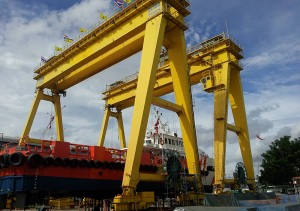
Construction Equipment Outdoor Gantry Crane for Outdoor
Choose the Best Outdoor Gantry Crane for Your Heavy Lifting
Selecting the right outdoor gantry crane is essential to ensure efficient, safe, and cost-effective lifting operations. The choice largely depends on your workload, site conditions, and specific application. For small to medium-sized operations with loads up to 50 tons, a single girder gantry crane is typically the most practical choice due to its lighter structure, easier installation, and lower cost. For heavier loads or larger-scale operations, a double girder gantry crane offers greater lifting capacity, stability, and span.
If your work site is in an outdoor, high-wind environment, a truss gantry crane can provide the extra stability and reduced wind resistance needed for safe operation. For port and terminal applications, container gantry cranes are purpose-built for fast and efficient container handling, with the strength and speed to keep up with demanding shipping schedules. In the construction industry, particularly for moving precast concrete elements, a precast concrete gantry crane is specifically designed to handle large, heavy, and awkwardly shaped loads with precision.
Partner with a reliable manufacturer or supplier who has proven expertise in designing and producing outdoor gantry cranes. An experienced provider will not only deliver high-quality equipment but also offer tailored solutions, installation support, and long-term service—ensuring your investment works safely and efficiently for years to come.
Safety Devices for Outdoor Gantry Cranes
When operating an outdoor gantry crane, safety should always be the highest priority. These powerful machines handle heavy loads in environments that often expose them to wind, weather, and operational hazards. Equipping your crane with the right safety devices not only protects personnel and equipment but also helps maintain operational efficiency and prolong the crane’s service life.
1. Overload Protection
An overload protection device is essential for preventing the crane from attempting to lift more than its rated capacity. When a load exceeds the safe limit, the system automatically interrupts lifting operations, ensuring that structural components and lifting mechanisms are not overstressed. This greatly reduces the risk of mechanical failure, accidents, and costly downtime.
2. Emergency Stop Button
Every outdoor gantry crane should be equipped with easily accessible emergency stop buttons. In the event of an unexpected hazard—such as an obstruction, mechanical malfunction, or sudden operator error—the emergency stop can immediately halt all crane movements. This quick response capability is vital for preventing injuries and avoiding damage to both the crane and surrounding infrastructure.
3. Limit Switches
Limit switches are designed to control the maximum range of movement for the crane’s hoist, trolley, and bridge. For example, a height limit switch will stop the hoist before it reaches its upper or lower extremes, while travel limit switches will prevent the trolley or gantry from moving beyond its safe operational boundaries. By automatically stopping motion, limit switches reduce wear and tear on mechanical components and prevent collisions.
4. Wind Sensors
Outdoor gantry cranes often operate in exposed areas, making wind safety a critical consideration. Wind sensors monitor wind speed in real time and can trigger warnings or automatic shutdowns if gusts exceed safe operating limits. This is particularly important for tall or long-span cranes, where wind forces can affect stability and control.
Incorporating these safety devices into your outdoor gantry crane setup ensures that your lifting operations remain safe, reliable, and compliant with industry standards—protecting both your workforce and your investment.




How to Maintain an Outdoor Gantry Crane
Outdoor gantry cranes are vital for handling and transporting heavy loads in industries such as construction, shipping, and manufacturing. However, because they operate in open environments, they are constantly exposed to harsh weather conditions—sun, rain, snow, humidity, and dust—that can accelerate wear and tear. Regular and proper maintenance is the key to ensuring their safe, reliable, and long-lasting performance.
1. Clean Regularly
Dirt, dust, salt, and industrial residues can accumulate on the crane’s structure, leading to corrosion, reduced efficiency, and premature component failure. A thorough cleaning schedule should be established, ideally after each major operation or at least on a weekly basis. Use a high-pressure washer to remove stubborn grime from large surfaces and a stiff-bristled brush for hard-to-reach areas. Pay special attention to joints, welds, and corners where moisture and debris tend to collect. Regular cleaning not only prevents corrosion but also makes it easier to spot cracks, leaks, or other potential issues early.
2. Apply Anti-Rust Coating
Given their constant exposure to outdoor elements, outdoor gantry cranes are highly susceptible to rust. Applying an anti-rust coating acts as a protective shield, preventing moisture and oxygen from corroding the steel components. Common options include industrial-grade anti-rust paints, zinc-rich primers, oil-based coatings, or wax layers. The choice of coating should depend on the crane’s material, location, and environmental conditions—such as whether it operates near salty coastal air. Before applying, ensure the surface is clean and dry, and follow the manufacturer’s recommendations for even and complete coverage. Reapply coatings periodically, especially after repainting or repair work.
3. Lubricate Moving Parts
The mechanical components of a gantry crane—gears, pulleys, bearings, wheels, and wire ropes—must move smoothly to avoid excessive friction and wear. Without proper lubrication, these parts may seize, degrade faster, and even cause safety hazards. Use high-quality industrial lubricants that are resistant to water washout and temperature fluctuations. Lubrication should be carried out according to the manufacturer’s schedule, but more frequent application may be necessary in wet or dusty environments. In addition to reducing wear, fresh lubrication can help displace moisture and prevent rust buildup on metal surfaces.
4. Conduct Routine Inspections
Beyond cleaning, coating, and lubrication, a structured inspection program should be in place. Check for cracks, loose bolts, abnormal noises, and electrical issues. Inspect load-bearing components for deformation or wear, and replace damaged parts immediately to avoid accidents.
















